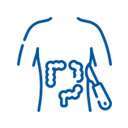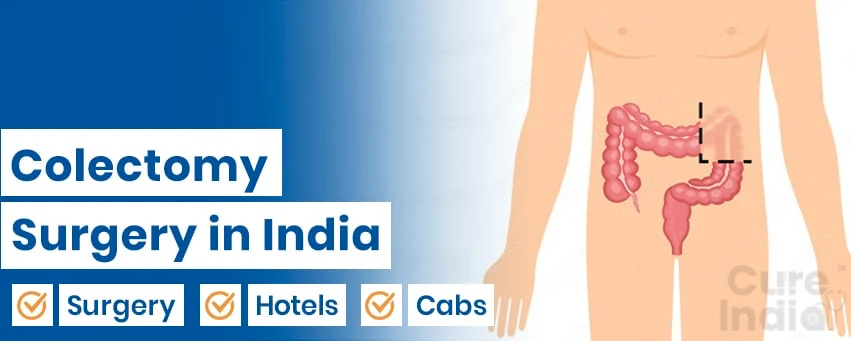

Colectomy is a surgical procedure that is used to remove either a part of a colon or an entire colon. A colon is a part of your digestive system also known as the large intestine. The colon is a tube-like organ that is continuous from the small intestine and ends towards the rectum. Its function is to absorb the nutrients, water, and electrolytes from the food and carry the remaining food waste from the small intestine, and pass it to the rectum where it is stored and then excreted from the body through the anus. The reason a colectomy procedure is done is to treat various medical conditions like cancer or any colon diseases that cannot be treated with medicines and can spread the infection. Removing the diseased part of the colon prevents the disease to spread in the rest of the digestive tract and surrounding tissues.
With the worldwide increase in colon diseases, the African countries where colon diseases were rare, are also experiencing an increase in colon illnesses. Colorectal cancer is increasing every year in the entire world and its treatment is insufficiently available in many low-income countries. Due to this many patients with colon illness decide to travel to other countries seeking proper medical care. Every year, a lot of people from Tanzania, Kenya, Ethiopia, Cameroon, and many other African countries visit India for various treatment options. Indian hospitals have the latest and modern technologies that increase the chances of successful treatment procedures. Indian hospitals have highly experienced surgeons and world-class infrastructure. With advanced and quality medical care, the cost of the treatments remains low in India which is highly profitable for patients travelling from many different countries.
The colectomy procedure is used to treat various colon diseases including cancer, diverticulitis, inflammatory diseases, or any other diseases that cannot be treated with medications. The common colon diseases that can be treated with colectomy are explained below.
■ Colon Cancer: It is very important to remove the part of your colon that has developed colon cancer because if not done so, it can spread and cause major complications in the body.
■ Crohn’s Disease: It is an inflammatory disease. It causes severe inflammation in the gastrointestinal tract from the stomach up to the anus.
■ Ulcerative Colitis: It is also an inflammatory disease. It causes chronic ulcers in the lining of your colon which leads to severe inflammation.
■ Diverticulitis: It is an inflammatory disease of the GI tract. It causes inflammation in the small pockets (known as diverticula) that develop in the lining of the colon. It generally affects elderly people.
■ Large intestine obstruction: This condition is characterized by chronic blockage of the colon which may be caused by a volvulus (twist), or by stricture (narrowing) of the colon.
■ Precancerous stage: If you have a family history of colon cancer such as Lynch Syndrome or Familial Adenomatous Polyposis (FAP), or if your colonoscopy test shows that you have an increased chance of developing cancer in a particular part of your colon, then your surgeon may suggest you opt for a colectomy to remove the colon part that is at high risk of developing cancer.
■ Severe Bleeding: An injury in the colon may lead to uncontrolled bleeding that cannot be treated from outside. If the bleeding in the colon is not stopped, it can cause major complications. Hence, colectomy comes to the rescue.
There are various types of colectomy procedures. Based on how much portion of your colon has to be removed, your surgeon will decide which colectomy procedure to choose. Depending on your condition and suitable treatment, your surgeon may perform one of the following colectomy procedures. The different colectomy types are mentioned below.
In this procedure, an entire colon is removed i.e. starting from the small intestine and ending to the rectum.
It is also known as Subtotal Colectomy. In this procedure, only a portion of the colon is removed. There are many subtypes of these procedures which are mentioned below.
It is also known as Sigmoidectomy. In this procedure, only the last portion (known as the sigmoid colon) of the colon which is connected to the rectum is removed.
The hemicolectomy procedure involves, the removal of only one side of the colon. If the descending colon is removed, it is known as a left-side hemicolectomy and if the ascending colon is removed, it is known as a right-side hemicolectomy. The ascending colon is the first half portion of a colon and the descending colon is the latter half portion of a colon.
Proto refers to the rectum. In this procedure, the rectum is also removed along with either a part of the colon or an entire colon.
After successfully removing the entire colon or a part of the colon, the remaining portion of the colon needs to be connected in order to maintain the body’s ability to remove the food waste from the digestive tract. Your surgeon may perform the following procedure right after the colectomy or it may be done later.
This procedure is done right away following colectomy. In this procedure, the two ends from which the part of the colon is removed, are connected to each other to make your intestine complete again.
It is also referred to as Ileostomy: This procedure is done later after the colectomy procedure. It is done when the colon ends cannot be connected right after colectomy. In this procedure, the surgeon creates an opening known as a stoma inside the wall of the abdomen. And the end parts of the severed colon are redirected to this stoma. A bag/pouch is attached to the stoma that will collect the feces. It could be temporary or permanent.
This procedure is mostly done if a patient has a proctocolectomy surgery. In this procedure, the surgeon creates a pouch from the portion of the small intestine and attaches it to the anus. This will help in eliminating the feces from the body.
Many people from African nations like Ghana, Uganda and Cameron visit India for the Colectomy procedure. Indian hospitals have the best equipments and medical devices that aid proper diagnosis and treatment. Indian surgeons are highly experienced and well-trained with the latest technology in the field of healthcare. For colectomy, Indian hospitals provide procedures like total colectomy, partial colectomy, hemicolecomy, proctocolectomy, laparoscopic-assisted colectomy, and robotic-assisted colectomy. The cost of colectomy in India is less than the western countries. The reasons are more patients, low cost of stay, affordable hospitals. Mentioned below is the cost of colectomy in India.
| Treatment in India | Cost in India | Stay in India |
|---|---|---|
| Colectomy Surgery in India | $2,000 | 7-10 Days |
Before scheduling your colon removal surgery, your surgeon will examine your health and the condition of the colon by running some tests like blood tests, X-rays, urinalysis, electrocardiogram, colonoscopy, etc. It is very important that your colon is empty before the surgery and therefore you need a prepare yourself for it in advance. Your doctor will ask you to consume only liquid and no solid food for a couple of days before this procedure. Your doctor may also recommend you to consume laxatives or go for an enema to clear out your colon.
On the day of the surgery, you should fast and not eat or drink anything. After taking you to the operation theater, your heart rate, breathing, and blood pressure will be continuously monitored. You may also be given an antibiotic medication through an IV. One of the members of the medical staff will give you general anesthesia to make you unconscious so that you will not feel any pain during the surgery. After that, your surgeon will proceed with the colectomy procedure. The colectomy procedure can be done following two approaches.
In the open surgery an incision of about 5-6 inches is made on the abdomen and then the surgery is performed. In this procedure, the surgeon first sanitizes the incision site and makes an incision. After making an incision, with the help of surgical tools, your surgeon will separate the colon from the surrounding tissues and excise either the part of the colon or an entire colon depending upon what type of colectomy is being performed. After cutting the diseased colon, it is removed from the body, and the ends of the remaining colon are either connected together or a pouch is attached to store the feces. After completion of the surgery, the incision is then closed with stitches.
Unlike open colectomy, where only one large incision is made, in laparoscopic colectomy, multiple cuts are made but of smaller size. In this procedure, after sanitising the incision site, your surgeon will make small incisions on the abdomen. Then he/she will insert a laparoscope with a camera and a lighting device attached to it through one of the incisions. This will provide a video of the internal parts of your abdomen on a TV monitor. From the other incisions, the surgical tools will be inserted. Your surgeon will watch the TV screen and perform the procedure. After separating the colon from the surrounding tissues, the colon will be removed from one of the incisions. If the repair has to be made, your surgeon will do so, and then reinsert the part of the colon. After this, the incisions are closed with stitches.
Besides open and laparoscopic colectomy, surgeons in India are using the latest and modern technologies like robotic colectomy to perform this surgery. In robot-assisted colectomy, the operation is conducted in the same way as the laparoscopic approach, it requires even smaller incisions and the surgeons use the robotic arms to perform the surgery. The recovery period following this approach of colectomy is comparatively less than open colectomy and laparoscopic colectomy.
After the surgery is completed, you will be taken to the recovery room to monitor your condition until the anesthesia wears off. Colectomy is a major surgery and requires a long recovery time. After the procedure, you might need to stay at the hospital for a few days to a week. You will be fed with the fluids through an IV in your arm initially, and then you will slowly start to consume a clear liquid diet. Your intestine will gradually start to recover and you will start to eat soft food. If you have a pouch (stoma) attached to your abdomen to store the feces, your nurse will guide you in taking care of the stoma and how to change an ostomy bag that collects the feces. You may feel discomfort and pain for the first few days after the surgery but as you rest and recover, you will be fine. Before you leave from the hospital, your surgeon will guide you on how to take care of the surgical wound, what diet to consume, how to change the bag, etc.
Colectomy is a major surgery and requires the expertise of your surgeon. It is a required procedure if you have colon cancer, inflammatory diseases of the GI tract, or any other colon diseases. If left untreated, it can cause various complications in the body. With an increase in the global prevalence of colorectal diseases, the requirement for colectomy procedures has also increased. Many developed countries provide surgery for colon diseases but the cost is too high and is not affordable for many patients traveling from other countries. Despite being a developing country, India provides the best medical procedures, and that too at a very low cost. For your reference, you can compare the cost of colectomy in India to the costs in other countries in the cost section mentioned above.
